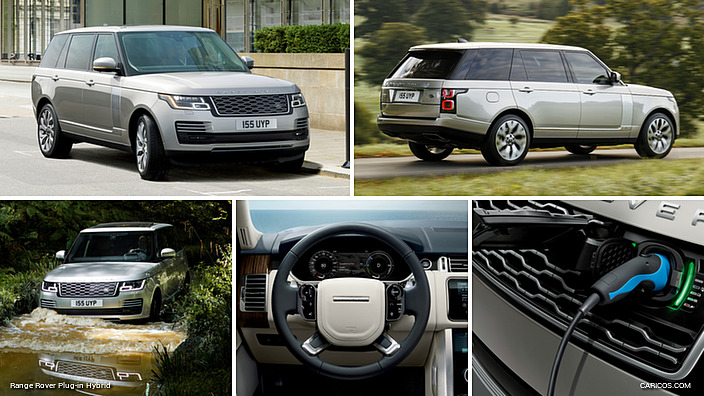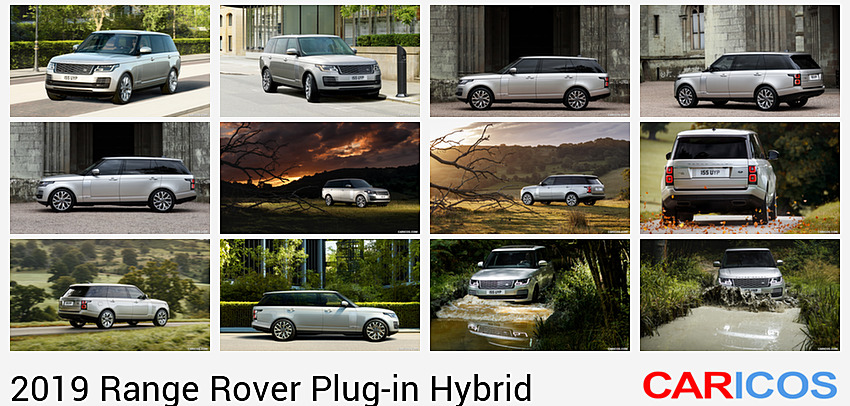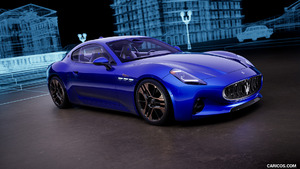Range Rover Plug-in Hybrid
Following the announcement of the new Range Rover Sport plug-in hybrid electric vehicle (PHEV) last week, the brand’s ICE to ACE journey continues, moving from conventional internal combustion engines to connected and electrified vehicles. The Range Rover PHEV and Range Rover Sport PHEV models represent the first steps for Land Rover on the path that will see all new Jaguar and Land Rover vehicles launched from 2020 offering an electrified powertrain option.
The efficient new Range Rover P400e provides sustainable performance by combining a 296hp 2.0-liter four-cylinder Ingenium gasoline engine with a 114hp (85kW) electric motor. The 398hp total available power output4 – available through the permanent four-wheel drive system – delivers 0-60mph in 6.4 seconds (0-100km/h in 6.8 seconds) and a maximum speed of 137mph (220km/h).
With an impressive 472-lb. ft. of torque, the new powertrain delivers dynamic performance with traditional Range Rover capability, comfort and refinement.
The Range Rover P400e provides an all-electric range of up to 31 miles (51km)3 without the Ingenium gasoline engine running. For the first time, customers choosing the flagship Land Rover SUV can experience zero-emission driving.
Drivers of the new PHEV model can choose from two driving modes:
- Parallel Hybrid mode (the default driving mode) – combines gasoline and electric drive. The driver can optimize battery charge or fuel economy by utilizing one of two charge management functions:
- SAVE function – prevents the battery charge dropping below a pre-selected level
- Predictive Energy Optimization (PEO) function – entering a destination in the navigation system enables the feature, which utilizes in built GPS altitude data for the selected route, to intelligently combine the electric motor and petrol engine to maximize fuel economy
- EV (Electric Vehicle) mode – enables the vehicle to run solely on the electric motor using the energy stored in the battery, the ideal solution for quiet, zero-emission journeys
The powertrain’s precision and control make for serene progress in various conditions and terrains. The Land Rover Terrain Response® 2 technology has a unique calibration to intelligently and precisely distribute torque from the electric motor, which has no creep speed and is able to deliver maximum torque from zero rpm, to all four wheels. This gives greater control during low-speed off-road maneuvers, confirming the Range Rover brand’s outstanding breadth of effortless capability.
 2019 Range Rover Plug-in Hybrid
2019 Range Rover Plug-in Hybrid
The Range Rover 2.0-liter Ingenium gasoline engine is longitudinally mounted, with the 85kW electric motor housed in the ZF® automatic eight-speed transmission at the center of the vehicle alongside the 7kW on-board charger. The access point for the cable is at the front of the vehicle, while the prismatic cell lithium-ion battery is mounted at the rear beneath the trunk floor.
Designed and engineered by Jaguar Land Rover in the UK, the new Range Rover will be produced at the company’s Solihull production facility and is available to order now, with first deliveries from the end of 2017 (market dependent).
Unrivalled capability and peerless refinement meet sustainable luxury with the introduction of plug-in gasoline-electric power to the 2019 MY Range Rover1. The first Plug-In Hybrid Electric Vehicle (PHEV) powertrain available from Jaguar Land Rover is capable of up to 31 miles (51km)2 with zero tailpipe emissions when driven in all-electric mode, providing sustainable performance like never before.
Plug-in Hybrid Electric Vehicle
The 2019 PHEV model, badged P400e, combines an advanced 296hp four-cylinder Ingenium gasoline engine with a 114hp (85kW) electric motor. This transformational technology is powered by an advanced 13.1kWh lithium-ion battery giving a total available power output of 398hp3 from the permanent four-wheel drive (4WD) system.
Together they drive the brand’s performance SUV from 0-60mph in just 6.4 seconds (0-100km/h in 6.8 seconds) for SWB variants and to a top speed of 137mph[iv]. With an impressive 472-lb. ft. of torque, the new powertrain mixes dynamic and sustainable performance with traditional Range Rover capability, comfort and refinement.
The combination of Ingenium gasoline and electric power can be used in two driving modes: Parallel Hybrid mode (the default driving mode) and EV (Electric Vehicle) mode.
In Parallel Hybrid mode the 2019 PHEV model can intelligently and seamlessly combine the two power sources to deliver efficient performance. By using its electrical energy reserves intelligently the P400e is able to offer the power and capability customers demand from a Range Rover.
On longer journeys, customers can use the SAVE function to deploy the EV-only range for a specific part of their journey, for example, when entering congested urban areas, while the Predictive Energy Optimization function uses the vehicle’s Navigation system to enhance fuel efficiency.
In EV mode the P400e can be driven up to 31 miles (51km)3 with zero-emissions when fully charged. This driving mode is manually selected using a button on the console and gives the new PHEV model a top speed of 85mph (137km/h)5 when using only EV power.
The intelligent system can also capture and store the energy generated when braking to help recharge the battery.
The 2.0-liter Ingenium engine can be found under the clamshell hood, with the 85kW electric motor housed on the transmission, at the center of the vehicle.
The access point for the 7kW on-board charging socket is located behind the Land Rover badge to the right of the grille, at the front of the vehicle, while the 13.1kWh prism-shaped lithium-ion battery is mounted at the rear beneath the trunk floor.
Charging
The new 2019 Range Rover PHEV model features a plug-in charge point behind a discreet panel on the grille, a 7kW on-board charger, and a charging cable. Based on market and type of hardware used, the Range Rover P400e is suited to deliver full battery charging overnight using a domestic plug socket.
The PHEV model is available with three types of cables and includes a home charging lead, which connects to domestic power supplies, as standard.
The public charging cable, which is compatible with AC wall boxes installed at domestic and business premises and service stations, makes it ideal for charging on the move.
Timed charging is also available via the vehicle’s infotainment system, which allows owners to choose the most appropriate time to begin charging – perfect for customers who want to plug in when they return home, but want to wait until a less costly energy price is available.
Owners can monitor the charging status via two illuminated strips that sit either side of the charging socket behind the grille. A white light signifies the vehicle is connected but indicates that charging has not started, while a blue light shows that timed charging is set but not underway. A flashing green signal shows the car is charging, while a solid green light indicates the battery is fully charged.
When customers are away from their vehicle, they can use the InControl Remote™ app to monitor the charge status, as well as receive an alert if there is an error, or the cable has been removed forcibly.
Functionality
The gasoline engine and electric motor of the P400e have been calibrated to work in harmony regardless of the state of battery charge, with two charge management functions available when driving in Parallel Hybrid mode:
Predictive Energy Optimization helps to make the most of both power sources and is activated when the driver enters a destination into the navigation system. By analyzing factors such as traffic conditions, gradient of the route and whether it is an urban or rural environment, the PHEV system will seamlessly combine electric and Ingenium gasoline engine power to optimize efficiency. The driver-selectable SAVE mode is accessed through the Touch Pro Duo system and maintains battery charge at the point of activation. At this point, the vehicle will only use the electric motor once it has replenished enough energy via regenerative braking or charging, allowing customers to conserve electric power to be used on a specific part of their journey.
The operation of the PHEV powertrain is supported by the latest ZF8P75XPH eight-speed automatic transmission, which combines lightweight construction and highly efficient operation to reduce fuel consumption while delivering the supreme refinement and assured responses Range Rover customers expect. The advanced transmission adapts to individual driving styles, so dynamic driving is automatically accompanied by quicker gear changes.











